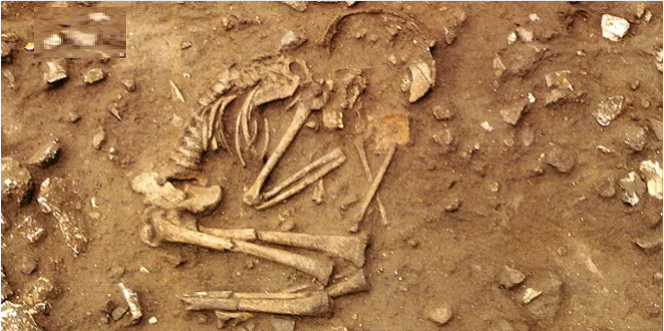Burial positions among the ancient Amazighs

The ancient Amazighs paid great attention to the process of burying the dead, and this is due, without a doubt, to their intense interest in the phenomenon of death, their strong adherence to their religious beliefs, and their fear that humans or animals, or natural conditions or time, would tamper with their dead. Therefore, the Amazighs built graves and practiced accompanying funeral rituals. For the burial process. Three main burial positions have been identified:
The folded position (position repliée) is a primitive burial position found on all continents and not limited to North Africa. It consists of placing the dead body on the ground on the right or left side so that the lower limbs are bent towards the abdomen, and the upper limbs are attached to the chest and facing towards the face. Sometimes the hands hold a vessel, as in some “Roknia(Guelma)” graves. “. Gabriel Camps says that the results indicate that placing the body on the right side is a ritual characteristic of southern regions, while in the north the body is placed on the left side. It seems that the desire to put the dead person to rest or sleep was behind the Amazighs choosing this position, especially since its shape closely imitates a sleeping person. Introverted burial position, Chien Tafidat Cemetery - Niger

-The contracted or “fetal” position (contractée or fœtale position): This position reflects the desire to give the body the shape of a fetus in the mother’s womb, so that the knees and hands touch the face, the heels connect to the pelvic bone, and the front limbs stick to the chest. In this position, it is often The dead person is tied with a leather belt, and the spine is often broken by severe bending, as in some of the graves of the city of “Ishoqan.” . Researchers have given several explanations for this situation. Some of them believe that it was used for the purpose of economy in building the tomb, making do with a narrow hole and small rubble. Others believe that the fear of the dead returning to spoil the lives of the living is the main reason for the Amazighs choosing this situation, and they justify their opinion with the restriction that is subjected to it. He has the dead body until he is unable to move or stand. But there is another opinion that is closer to logic, which is the desire of the living to express the fetus in its mother’s womb, meaning that it symbolizes the return of the human being to his origin and origin. Shrunken burial position, Chien Tafidat Cemetery - Niger
- The extended position (position allongée): In this case, the dead person is buried lying down, whether on his right side or on his back. Some researchers believe that the Amazighs may have borrowed this custom from the Phoenicians, Greeks, or Romans, and supports the idea of adopting it in a late period, referenced by “Herodotus.” It was practiced by the Libyans in the fifth century BC, and Phoenician-Numidian and Roman coins were found in many of the tombs in which this ritual was practiced.

. Jugurtha Hannachi
the reviewer
Rabah Lahcen, The large numbers of people and their families G. Camps, «Inhumation», in the Encyclopédie Berbère, 24 | Ida – Issamadanen [Online], on June 1, 2011, consulted on March 22, 2017. URL: http://encyclopedieberbere.revues.org/1577

